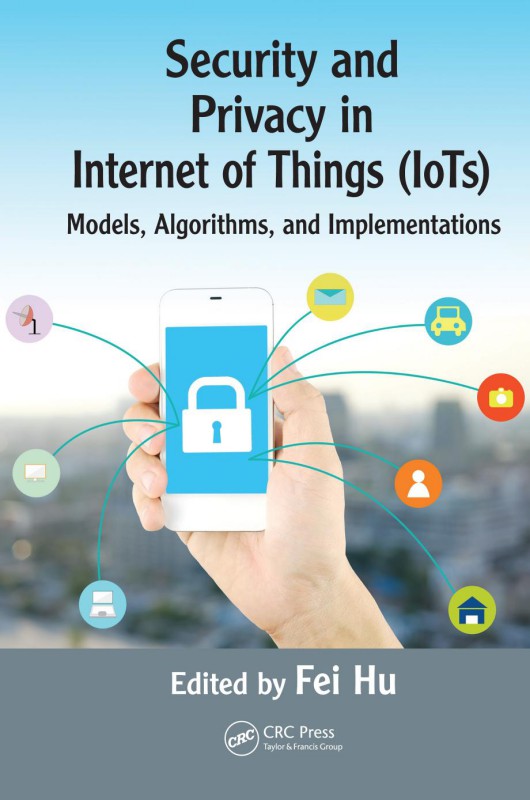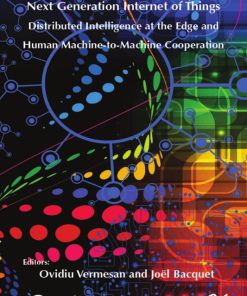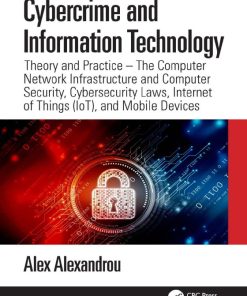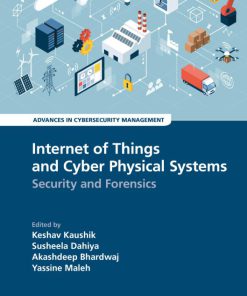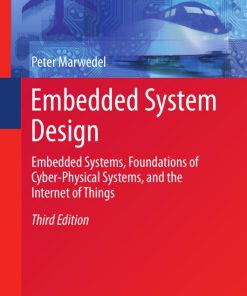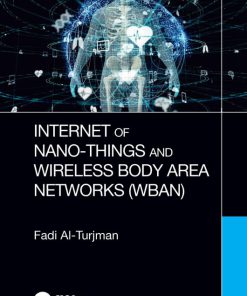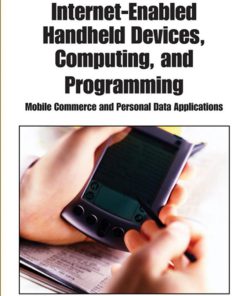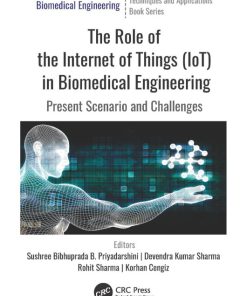Security and Privacy in Internet of Things Iots Models Algorithms and Implementations 1st Edition by Fei Hu ISBN 9781040070864 1040070868
$50.00 Original price was: $50.00.$25.00Current price is: $25.00.
Authors:Fei Hu , Series:IT & Computer [221] , Tags:Computer Communication Networks; Information Technology , Author sort:Hu, Fei , Ids:Google; 9780367574925 , Languages:Languages:eng , Published:Published:Jun 2020 , Publisher:Taylor & Francis Group , Comments:Comments:The Internet of Things (IoT) has attracted strong interest from both academia and industry. Unfortunately, it has also attracted the attention of hackers. Security and Privacy in Internet of Things (IoTs): Models, Algorithms, and Implementations brings together some of the top IoT security experts from around the world who contribute their knowledge regarding different IoT security aspects. It answers the question How do we use efficient algorithms, models, and implementations to cover the four important aspects of IoT security, i.e., confidentiality, authentication, integrity, and availability?The book consists of five parts covering attacks and threats, privacy preservation, trust and authentication, IoT data security, and social awareness. The first part introduces all types of IoT attacks and threats and demonstrates the principle of countermeasures against those attacks. It provides detailed introductions to specific attacks such as malware propagation and Sybil attacks. The second part addresses privacy-preservation issues related to the collection and distribution of data, including medical records. The author uses smart buildings as an example to discuss privacy-protection solutions.The third part describes different types of trust models in the IoT infrastructure, discusses access control to IoT data, and provides a survey of IoT authentication issues. The fourth part emphasizes security issues during IoT data computation. It introduces computational security issues in IoT data processing, security design in time series data aggregation, key generation for data transmission, and concrete security protocols during data access. The fifth and final part considers policy and human behavioral features and covers social-context-based privacy and trust design in IoT platforms as well as policy-based informed consent in the IoT.
Security and Privacy in Internet of Things Iots Models Algorithms and Implementations 1st Edition by Fei Hu – Ebook PDF Instant Download/Delivery. 9781040070864 ,1040070868
Full download Security and Privacy in Internet of Things Iots Models Algorithms and Implementations 1st Edition after payment
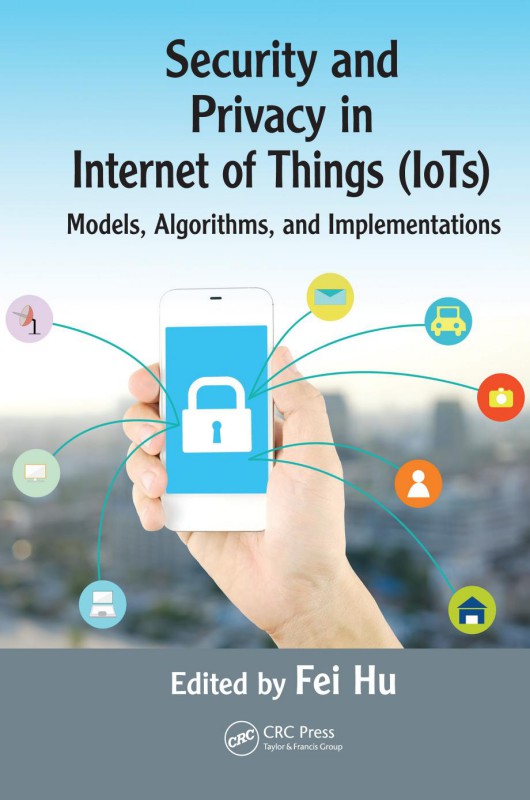
Product details:
ISBN 10: 1040070868
ISBN 13: 9781040070864
Author: Fei Hu
Security and Privacy in Internet of Things Iots Models Algorithms and Implementations 1st Edition Table of contents:
I: THREATS AND ATTACKS
1 Internet of Things (IoT) as Interconnection of Threats (IoT)
1.1 Introduction
1.2 Phases of IoT System
1.2.1 Phase I: Data collection, acquisition, perception
1.2.2 Phase II: Storage
1.2.3 Phase III: Intelligent processing
1.2.4 Phase IV: Data transmission
1.2.5 Phase V: Delivery
1.3 Internet of Things as Interconnections of Threats (IoT vs. IoT)
1.3.1 Phase attacks
1.3.1.1 Data leakage or breach
1.3.1.2 Data sovereignty
1.3.1.3 Data loss
1.3.1.4 Data authentication
1.3.1.5 Attack on availability
1.3.1.5.1 Flooding by attackers
1.3.1.5.2 Flooding by legitimates (flash crowd)
1.3.1.5.3 Flooding by spoofing attackers
1.3.1.5.4 Flooding by aggressive legitimates
1.3.1.6 Modification of sensitive data
1.3.2 Attacks as per architecture
1.3.2.1 External attack
1.3.2.2 Wormhole attack
1.3.2.3 Selective forwarding attack
1.3.2.4 Sinkhole attack
1.3.2.5 Sewage pool attack
1.3.2.6 Witch attack
1.3.2.7 HELLO flood attacks
1.3.2.8 Addressing all things in IoT
1.3.2.9 Distributed denial of service (DDoS)
1.3.2.10 Flash crowd
1.3.2.11 IP spoof attack
1.3.2.12 Types of spoof attacks
1.3.2.13 Goodput
1.3.2.14 Data centers (DCs)
1.3.2.15 Botnet
1.3.2.16 Confidentiality
1.3.2.17 Physical security
1.3.2.18 Software security
1.3.2.19 Network security
1.3.2.20 Legal service-level agreement (SLA) issues
1.3.2.21 Eavesdropping
1.3.2.22 Replay attack
1.3.2.23 Back door
1.3.2.24 Sybil attack
1.3.2.25 Byzantine failure
1.3.2.26 Data protection
1.3.2.27 Incomplete data deletion
1.3.3 Attacks based on components
Bibliography
Chapter 2: Attack, Defense, and Network Robustness of Internet of Things
2.1 Introduction
2.2 Centrality Attacks, Network Resilience, and Topological Defense Scheme
2.2.1 Centrality attacks
2.2.2 Network resilience
2.2.3 Topological defense scheme
2.3 Game-Theoretic Analysis of Network Robustness and Fusion-Based Defense Scheme
2.4 Sequential Defense Scheme
2.5 Conclusion
Acknowledgment
Bibliography
Chapter 3: Sybil Attack Detection in Vehicular Networks
3.1 Introduction
3.2 Related Work
3.3 Location Certificate-Based Scheme
3.3.1 Sybil node detection scheme
3.4 Formal Modeling and Verification
3.5 Conclusion
3A Appendices
3A. 1 Vehicle proctype
3A. 2 RSU proctype
3A. 3 CA proctype
Bibliography
Chapter 4: Malware Propagation and Control in Internet of Things
4.1 Introduction
4.2 Malware Schemes in IoT
4.2.1 Modeling from the view of individuals
4.2.2 Modeling from the viewpoint of whole networks
4.2.3 Control of malware propagation
4.2.4 Optimal control of malware propagation
4.3 Modeling Malware Dynamics from the Individual Viewpoint
4.3.1 Impulse-free model (IFM)
4.3.1.1 Expected malware level E[X(t)]
4.3.1.2 Incubation period Tand remaining lifetime R
4.3.1.3 Transition probability Pij(t)
4.3.2.1 Incubation period T and remaining lifetime R
4.3.2.2 Transition probability Pij(t)
4.3.2.3 Steady-state probability Pn
4.3.3 Numerical results
4.3.4 Summary
4.4 Modeling Malware Dynamics from the Network Viewpoint
4.4.1 Malware dynamics: SI model
4.4.1.1 Numerical results
4.4.1.2 Summary
4.4.2 Malware dynamics under malware control: SIR model
4.4.3 Performance evaluation
4.5 Optimal Control of Malware
4.5.1 Early-stage analysis
4.5.2 Performance evaluation
4.5.3 Summary
4.6 Conclusion
Bibliography
Chapter 5: A Solution-Based Analysis of Attack Vectors on Smart Home Systems
5.1 Introduction
5.1.1 Smart world
5.2 Related Work
5.3 The digitalSTROM Environment
5.4 Attack Vectors on SHS
5.4.1 Central digitalSTROM server
5.4.2 Smart control devices
5.4.3 Smart home communication bus
5.4.4 Remote third-party services
5.4.5 Two attack scenarios
5.5 SHS Hardening
5.5.1 Central digitaISTROM server
5.5.2 Smart control devices
5.5.3 Smart home communication bus
5.5.4 Remote third-party services
5.6 Solution Analysis
5.7 Conclusion
Bibliography
II: PRIVACY PRESERVATION
Chapter 6: Privacy Preservation Data Dissemination
6.1 Introduction
6.2 Problem Overview
6.2.1 Network model
6.2.1.1 Sensor nodes
6.2.1.2 Storage nodes
6.2.1.3 Mobile sinks
6.2.2 Threat model
6.3 Problem Formulation
6.3.1 Privacy scope
6.3.2 Motivation for privacy and availability definition
6.3.3 Uncertainty and information states
6.3.3.1 Modeling the uncertainty
6.3.3.2 Computing the information state
6.3.3.3 Information states in the network
6.3.4 Evaluation criteria
6.3.4.1 Privacy
6.3.4.2 Availability
6.3.4.3 Energy
6.3.5 Problem definition
6.3.6 Baseline data dissemination
6.3.6.1 Shortest path
6.3.6.2 Random coloring
6.4 SPG-based Data Dissemination
6.4.1 Spatial privacy graph
6.4.2 Enhancing privacy via a distributed coloring algorithm
6.4.2.1 Algorithm walk-through
Lemma 6.1
6.4.2.2 Algorithm challenges
6.4.3 Enhancing availability via message replication
6.5 Experiment Validation
6.5.1 Simulation methodology
6.5.2 Experiment results
6.5.2.1 Impact of p
6.5.2.2 Impact of ns
6.6 Related Work
6.7 Conclusion
Bibliography
Chapter 7: Privacy Preservation for IoT Used in Smart Buildings
7.1 Introduction
7.2 Overview of Smart Building Concept
7.2.1 Smart building subsystems
7.2.2 IoT devices used in smart buildings
7.2.3 Intelligence in smart buildings
7.3 Privacy Threats in Smart Buildings
7.3.1 Privacy of user behavior
7.3.2 Location privacy
7.3.2.1 Privacy issues with wireless LANs
7.3.2.2 RFID privacy issues
7.3.3 Visual privacy
7.4 Privacy-Preserving Approaches in Smart Buildings
7.4.1 Wireless LAN privacy-preserving approaches
7.4.2 RFID privacy-preserving approaches
7.4.3 Video surveillance privacy-preserving approaches
7.5 Smart Meter Privacy-Preserving Approaches
7.5.1 Anonymization approaches
7.5.1.1 Identity pseudonymization
7.5.1.2 Anonymity through trusted neighborhood gateways
7.5.2 Power consumption modification approaches
7.5.2.1 Load signature moderation
7.5.2.2 Power usage data masking
7.5.3 Encryption-based approaches
7.6 Concluding Remarks and Future Research
Bibliography
Chapter 8: Exploiting Mobility Social Features for Location Privacy Enhancement in Internet of Vehicles
8.1 Introduction
8.1.1 Related work
8.1.2 Contributions and organization of the paper
8.2 System Model
8.2.1 Network model
8.2.2 Threat model
8.2.3 Location privacy requirements
8.3 Proposed Location Privacy Preservation Scheme: MixGroup
8.3.1 Characteristics of vehicular social networks
8.3.2 Two observations from real vehicle traces
8.3.2.1 Observation one
8.3.2.2 Observation two
8.3.3 MixGroup: Brief overview
8.3.4 MixGroup: Detailed operations
8.3.4.1 System initialization and key generation
8.3.4.2 Group join
8.3.4.3 Pseudonym exchange
8.3.4.4 RSU signing protocol
8.3.4.5 Group leaving
8.3.4.6 Revocation protocol
8.3.4.7 Conditional tracking
8.3.4.8 Discussions
8.4 Security Analysis
8.4.1 Attack and defense analysis
8.4.1.1 GPA and RPA
8.4.1.2 Incorrect data attack
8.4.1.3 Liability attack
8.4.1.4 IBA and ITA
8.4.2 Entropy-optimal pseudonym exchange
8.5 Performance Evaluation
8.5.1 Global pseudonym entropy of VSN
8.5.2 Pseudonym entropy of target vehicle
8.5.3 Comparison with existing schemes
8.6 Conclusion
Acknowledgment
Bibliography
Chapter 9: Lightweight and Robust Schemes for Privacy Protection in Key Personal IoT Applications: Mobile WBSN and Participatory Sensing
9.1 Introduction
9.2 Lightweight and Robust Schemes for Protecting Privacy in Mobile WBSN
9.2.1 Related work
9.2.2 Problem formulation
9.2.2.1 Network model
9.2.2.2 Trust model and security requirement
9.2.3 Proposed schemes
9.2.3.1 One-time mask (OTM) scheme
9.2.3.1.1 Basic settings
9.2.3.1.2 Basic data structure
9.2.3.1.3 Data encryption and data upload
9.2.3.1.4 MA access
9.2.3.1.5 Security and performance analysis for OTM
9.2.3.2 One-time permutation (OTP) scheme
9.2.3.2.1 Security and performance analysis for OTP
9.2.3.3 Comparison and numerical results
9.3 A Lightweight and Robust Scheme for Privacy Protection in Participatory Sensing
9.3.1 Related work
9.3.2 Problem formulation
9.3.2.1 Network model
9.3.2.2 Attack model and design goals
9.3.3 Proposed scheme
9.3.3.1 Data trustworthiness
9.3.3.1.1 (Inf-policy-I) average
9.3.3.1.2 (Inf-policy-II) median
9.3.3.1.3 (Inf-policy-III) distance average
9.3.3.1.4 (Inf-policy-IV) time average
9.3.3.2 Reputation evaluation
9.3.3.2.1 (Eva-policy-I) threshold bias linear adjustment
9.3.3.2.2 (Eva-policy-II) exponential bias linear adjustment
9.3.3.2.3 (Eva-policy-III) exponential bias exponential adjustment
9.3.3.2.4 (Situation-I) inferred surrounding data are available
9.3.3.2.5 (Situation-II) inferred surrounding data are unavailable
9.3.3.4 Robustness enhancement
9.3.3.5 Analysis
Proposition 9.14
Proposition 9.15
Proposition 9.16
Proposition 9.17
Proposition 9.18
9.4 Conclusions
Acknowledgment
Bibliography
III: TRUST AND AUTHENTICATION
Chapter 10: Trust and Trust Models for the IoT
10.1 Introduction
10.1.1 Trust and security from a device perspective
10.1.2 Secure key storage
10.1.2.1 Hardware stores
10.1.2.2 Trusted platform modules
10.1.2.3 Software stores
10.1.3 Trust and security from a network perspective
10.2 Trust Model Concepts
10.2.1 Direct trust model
10.2.2 Web-of-trust model
10.2.3 Hierarchical trust model
10.2.3.1 Trust center infrastructures
10.2.3.2 Public key infrastructures
10.3 PKI Architecture Components
10.3.1 Certification authorities
10.3.2 Registration authorities
10.3.3 Validation authorities
10.3.4 Central directories
10.3.5 Timestamping authorities
10.3.6 Certificate revocation authorities
10.4 Public Key Certificate Formats
10.4.1 X. 509 certificates
10.4.2 Self-descriptive card verifiable certificates
10.4.3 Non-self-descriptive card verifiable certificates
10.4.4 Attribute certificates
10.5 Design Considerations for Digital Certificates
10.5.1 Device identifiers
10.5.2 Certificate validity
10.5.3 Public key cryptosystems
10.5.4 Hash functions
10.6 A Public Key Reference Infrastructure for the IoT
10.6.1 Certificate format
10.6.2 Certificate life cycle and number of device certificates
10.6.3 Combined identity and attribute certificates
10.6.4 Peer authentication protocols for the IoT
10.6.5 CA hierarchy
10.6.6 Certificate generation
10.6.7 Certificate validation
10.7 Summary
Bibliography
Chapter 11: Trustable Fellowships of Self-Organizing “Things” and Their Software Representatives: An Emerging Architecture Model for IoT Security and Privacy
11.1 Introduction
11.2 Current Technologies Limitations and Emerging Solutions for IoT
11.2.1 Naming and name resolution
11.2.2 Identifier/locator splitting
11.2.3 Resources, services, and content orchestration
11.2.4 Security, privacy, and trust
11.3 Introducing NG as an IoT Architecture
11.3.1 Naming and name resolution
11.3.2 Identifier/locator splitting
11.3.3 Resources, services, and content orchestration
11.3.4 Security, privacy, and trust
11.4 Example Scenario
Acknowledgments
Bibliography
Chapter 12: Preventing Unauthorized Access to Sensor Data
12.1 Introduction
12.2 Related Work
12.2.1 Cooperative authentication
12.2.2 Cooperation incentive
12.2.3 Conflict balancing
12.3 Preliminaries
12.4 Bargaining-Based Dynamic Game Model for Cooperative Authentication
12.4.1 Bargaining mechanism
12.4.1.1 Factors affecting price
12.4.1.3 Bargaining procedure
12.4.2 Dynamic game
12.4.2.1 Players
12.4.2.2 Strategy
12.4.2.3 Utility function
12.5 Analysis of Dynamic Game Model for Cooperative Authentication
12.5.1 Dynamic game with complete information
Theorem 12.1
Lemma 12.1
Lemma 12.2
12.5.2 Dynamic game with incomplete information
Theorem 12.2
12.6 Experimental Results
12.6.1 Location privacy leakage
12.6.2 Resource consumption
12.6.3 Network survival
12.7 Conclusion
Bibliography
Chapter 13: Authentication in IoT
13.1 Fundament of Authentication
13.2 Entity Authentication: Node Eviction in VANET
13.3 Message Authentication: Content Delivery in VANET
13.4 Key Management: Physiological Key Agreement in WBAN
Bibliography
IV: IOT DATA SECURITY
Chapter 14: Computational Security for the IoT and Beyond
14.1 Characterizing Complex Systems
14.1.1 Wireless networks
14.1.2 Biological networks
14.1.3 Social networks
14.1.4 Economic networks
14.1.5 Computer networks
14.2 Computational Tools for Complex Systems
14.2.1 Signal processing tools
14.2.2 Network science tools
14.2.3 Controllability and observability of networks
14.2.4 Network tomography
14.2.5 Lessons from communications engineering
14.3 Perspective Research Directions
Bibliography
Chapter 15: Privacy-Preserving Time Series Data Aggregation for Internet of Things
15.1 Introduction
15.2 Models and Design Goals
15.2.1 System model
15.2.2 Security model
15.2.3 Design goal
15.3 Preliminaries
15.3.1 Shi et al.’s privacy-preserving time series data aggregation scheme
15.3.2 Properties of group Zp2*
15.4 Proposed Time Series Data Aggregation Scheme
15.4.1 System settings
15.4.2 Data encryption at nodes
15.4.3 Data aggregation at gateway
15.4.4 Aggregated data decryption at control center
15.4.4.1 Discussion on privacy enhancement with differential privacy
15.4.4.2 Discussion on dynamic node joining and leaving
15.5 Security Analysis
15.6 Performance Evaluation
15.6.1 Computational costs
15.6.2 Communication costs
15.6.3 Utility in differential privacy enhanced version
15.7 Related Works
15.8 Summary
Bibliography
Chapter 16: A Secure Path Generation Scheme for Real-Time Green Internet of Things
16.1 Introduction
16.1.1 Data gathering of IoT
16.1.2 Key management of wireless embedded systems
16.2 Real-Time Query Processing in the Green Internet of Things
16.2.1 Real-time query processing in the green internet of things
16.2.2 Query processing in the green internet of things
16.2.2.1 Query plan in wireless sensor networks
16.2.3 Network model and problem definition
16.2.3.1 Query processing and network model
16.2.3.2 Problem definition
Problem 16.1
Problem 16.2
Problem 16.3
Theorem 16.1 NP-hardness.
16.2.4 A path generation framework
16.2.5 Properties
Lemma 16.1
Lemma 16.2
Corollary 16.1
16.2.6 Performance evaluation
16.2.7 Summary
16.3 Half-Key Key Management
16.3.1 Preliminaries
16.3.1.1 Background schemes
16.3.1.2 Motivation
16.3.2 The half-key-space predistribution scheme
16.3.2.1 Off-line phase: Key-space predistribution
16.3.2.1.1 Setting up of key-space pools
16.3.2.1.2 Key-space predistribution
16.3.2.2 Online phase: Session key establishment
16.3.3 Analysis study
16.3.3.1 Session key candidates analysis
16.3.3.2 Connectivity analysis of half-key space predistribution scheme using deployment knowledge
Lemma 16.3 [8]
Lemma 16.4 [17]
Theorem 16.2
Lemma 16.5 [17]
Lemma 16.6 [17]
Theorem 16.3
16.3.3.3 Resilience analysis of half-key space: Predistribution scheme using deployment knowledge
Lemma 16.7 [17]
Lemma 16.8
Theorem 16.4
16.3.4 Performance evaluation
16.3.5 Connectivity
16.3.5.1 Resilience against node capture
16.3.6 Summary
Bibliography
Chapter 17: Security Protocols for IoT Access Networks
17.1 Introduction to IoT
17.2 Related Works on Security Protocols
17.3 Time-Based Secure Key Generation and Renewal
17.3.1 Security access algorithms for unidirectional data transmissions
17.3.2 Security access algorithms for bidirectional data transmissions
17.4 Cognitive Security
17.5 Conclusions
References
Bibliography
V: SOCIAL AWARENESS
Chapter 18: A User-Centric Decentralised Governance Framework for Privacy and Trust in IoT
18.1 Introduction
18.2 Background and State of the Art
18.3 SocIoTal Security Framework
18.3.1 Context-driven security and privacy
18.3.2 Privacy-preserving identity management
18.3.3 Capability-based access control for IoT
18.3.3.1 Capability token
18.3.3.2 DCapBAC scenario
18.3.4 Secure group data sharing
18.3.4.1 Secure data-sharing scenario
18.4 Device-Centric Enablers for Privacy and Trust
18.4.1 Face-to-face enabler, from context to trust
18.4.1.1 From face-to-face to context
18.4.1.2 From context to trust
18.4.1.3 Related IoT service
18.4.1.4 Interfaces with authorization, trust and reputation management blocks
18.4.1.5 Initial evaluation of the F2F enabler
18.4.1.6 The F2F enabler as a tool
18.4.2 Indoor localization enabler: from context to access control
18.4.2.1 From context to access control
18.4.2.2 Related IoT service: Indoor localization
18.4.2.3 Interfaces with identity, trust and reputation management blocks
18.4.2.4 The indoor location enabler as a tool
18.4.2.5 Initial evaluation of the indoor localization enabler
18.5 Conclusion
Bibliography
Chapter 19: A Policy-Based Approach for Informed Consent in Internet of Things
19.1 Introduction
19.2 Problems Defining Informed Consent in the Internet of Things
19.3 State of Art
19.3.1 Dynamic and context-aware approach
19.3.2 Semiautonomous agent
19.3.3 Reputation systems
19.3.4 Behavior modeling
19.3.5 Analysis of the EULA
19.4 Overview of the System
19.4.1 Policy-based framework
19.4.2 Enforcement
19.4.3 Application of the SecKit framework to internet of things for informed consent
19.5 Conclusion and Future Developments
19.5.1 Information, training, and motivation of the user
19.5.2 Facilitating definition of rules and policy implementation
19.6 Acknowledgment
Bibliography
Chapter 20: Security and Impact of the Internet of Things (IoT) on Mobile Networks
20.1 Security Threats against IoT Embedded Devices and Systems
20.2 IoT Security Impacts against Mobile Networks
20.2.1 LTE network operation
20.2.2 Control plane signaling storms
20.2.3 Industry and security standardization work around M2M communications
20.2.4 IoT security research
20.3 Scalability of Large Deployments of Cellular IoT Systems
20.3.1 New network enhancements for mobile IoT systems
Bibliography
Index
People also search for Security and Privacy in Internet of Things Iots Models Algorithms and Implementations 1st Edition:
machine learning models and algorithms
model implementation
algorithm models
implement a model

